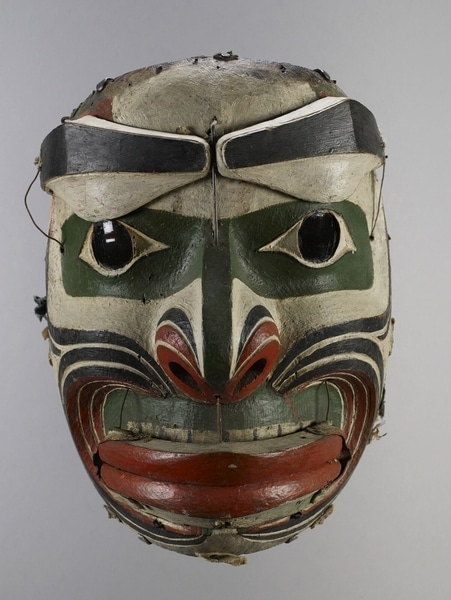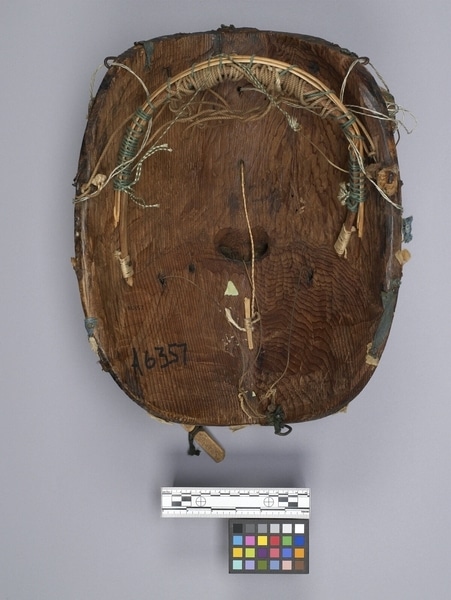Earthquake Mask Item Number: A6357 from the MOA: University of British Columbia




Description
Earthquake mask with movable eyebrows and lips and dark glassy eyes. The nostrils and cheeks are emphasized with curvilinear lines. The eyebrows and lips are controlled by cords that feed through to the reverse of the mask, where there is also a bent, movable wooden head strap. The mask is painted white with black eyebrows, green around the eyes, a vertical black band over the nose, black and red nostrils, red lips, green around the mouth, and black and red lines around the mouth and on the cheeks.
History Of Use
Used in Tlhasala. Before the mask was to be used, the platform on which guests sat had been rigged with strong lines running under them. When the mask appeared, men behind the mawilh pulled the ropes back and forth, causing the platforms to move. At the same time, earthquake-like noises were heard (J. Cook, K. Ferry, 1972). The eyebrows and mouth on this well engineered mask move in tandem when danced. When in motion, the mask tells us when Ninini (Earthquake) makes the land move. Gigaemi (Frank Baker) shared, “I would think when he wrinkles his face that the earth wrinkles, and that would be an earthquake.”
Iconographic Meaning
Represents Earthquake, Ninini.
Narrative
This Nininigamł (Earthquake mask) is a Nelson family prerogative from Gwa’yi (Kingcome Inlet) - the home of the Musgamagw Dzawada’enuxw, Kwakwaka’wakw. The Nelson family have ongoing rights to dance Ninini accompanied by a specific song. Ninini is performed during the Tlasila (Peace Dances) portion of the potlatch – a time where chiefly families open their Box of Treasures to validate their connections to specific land and resources by demonstrating ancestral knowledge of supernatural events, such as earthquakes. Kwakwaka’wakw chiefs and other knowledge holders who worked with MOA in the 1960s to better document the collection noted that the right to dance this and other Ninini masks originated among the Heiltsuk and Wuikinuxv peoples of the central coast, and came to Nakwaxda’xw (Kwakwaka’wakw) families of Ba’as, or Blunden Harbour where the privilege continued to be passed down through marriage and descent. This mask is documented as having been owned by Musgamakw Dzawada’enuxw hereditary chief Hector Webb (1892–1953) of Gwayi (Kingcome Inlet), and sold to MOA by his widow in 1954. The mask was danced during the potlatch of Musgamagw Dzawada’enuxw Chief Gigaemi (Frank Baker) in Alert Bay, in Oct. 2019.
Item History
- Made by John Davis (Maker) in British Columbia, Canada during 1910
- Collected in Kingcome Inlet, British Columbia, Canada and Ukwanalis, British Columbia, Canada
- Owned by Emily Watson before January 1954
- Received from H. R. MacMillan (Funding source) and Emily Watson (Seller) during January 1954
What
Who
- Culture
- Kwakwaka'wakw
- Creator
- John Davis (Maker)
- Previous Owner
- Emily Watson
- Received from
- H. R. MacMillan (Funding source) and Emily Watson (Seller)
Where
- Holding Institution
- MOA: University of British Columbia
- Made in
- British Columbia, Canada
- Collected in
- Kingcome Inlet, British Columbia, Canada and Ukwanalis, British Columbia, Canada
When
- Creation Date
- during 1910
- Ownership Date
- before January 1954
- Acquisition Date
- during January 1954
Other
- Condition
- fair
- Current Location
- Case 41
- Accession Number
- 1880/0004